'I was mistaken for a dummy in a fake Scottish train crash'
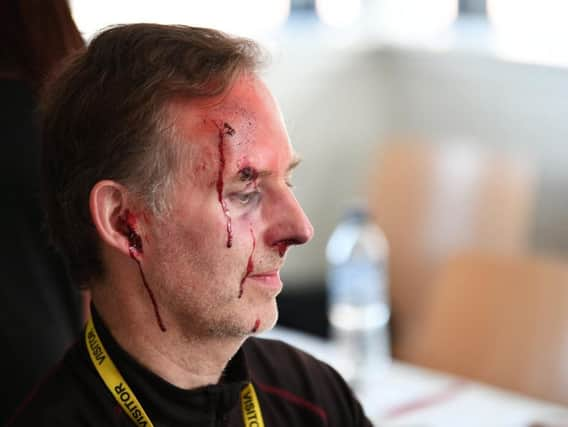

It had seemed an appropriate way to spend Friday the 13th – as the first journalist to play a casualty in a major transport exercise at the Scottish Fire and Rescue Service’s (SFRS) national training centre.
The role involved me pretending to have life-threatening injuries – a fractured pelvis and internal bleeding – and losing consciousness.
Advertisement
Hide AdAdvertisement
Hide Ad“We want a lot of shouting and screaming,” my fellow casualties were told by intensive care consultant Dr Richard Levin, one of the exercise’s coordinators. But turning to me, he added:
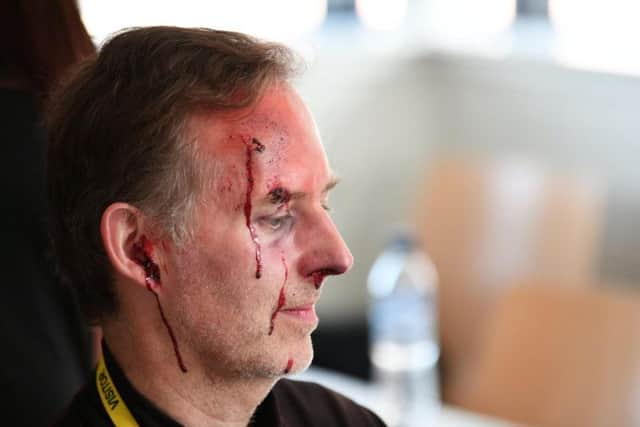

“You may be too sick to scream.”
The scene-setting was realistic down to my makeup, meticulously applied by hair and makeup lecturer Christine Brack, who’s worked with stars such as Alice Cooper, Melanie Griffith and Don Johnson.
Sporting nasty-looking cuts to my forehead, ear, eyebrow and nose, a slurp of stage blood – “zesty mint flavour and safe for use in the mouth” the Los Angeles-produced concoction assured – added to the gore.
I was accompanied on to the train, in a tunnel, by 11 of Brack’s fashion and media makeup students from West College Scotland in Paisley, who had also expertly transformed themselves for the part of fellow injured passengers. Some had even mimicked shards of glass embedded in their skin by attaching slivers from plastic bottles.
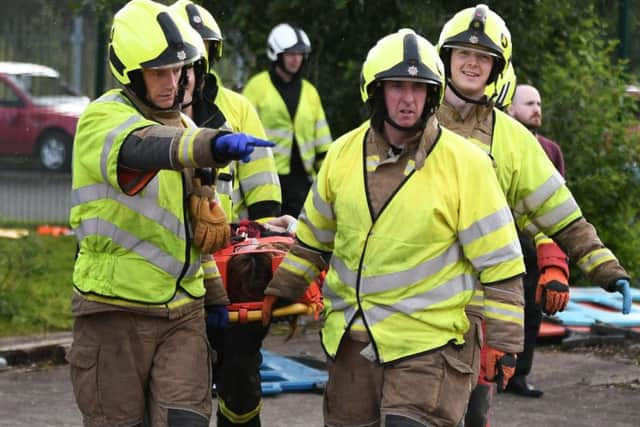

It was hard enough clambering over the wrenched-over train seats in the gloom to take up position, so I wondered how on earth my rescuers would get me out. The codeword, in case I got hurt in the attempt, was to say “For Real”.
But there wasn’t long to ponder before dark shapes made their way through the coach as firefighters tried to locate and assess the severity of the wounded.
“We did not think you were real at first,” 21-year-old trainee firefighter Tom Campbell told me afterwards. “We couldn’t see and thought you were a mannequin. You were at such an angle and under stuff. But when I put my foot down towards your leg, I thought ‘This is softer than a chair’.”
Suddenly, five firefighters were peering down at me, at once realising I was in a bad way. Acting in unison, they ensured my head was protected, then carefully “log rolled” me on to a “board” – a rigid plastic yellow stretcher – in what seemed an impossibly tight space to manoeuvre my nearly 6ft frame.
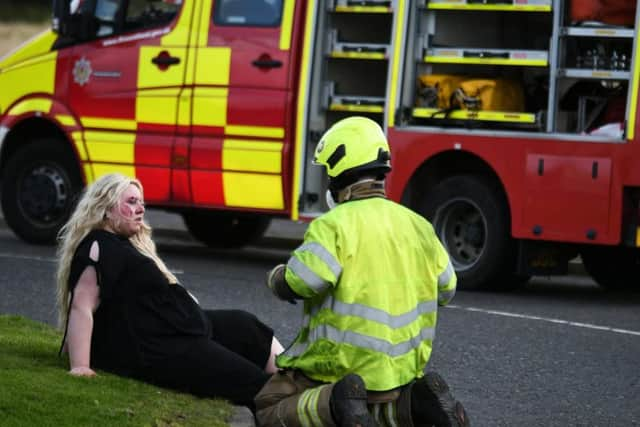

Advertisement
Hide AdAdvertisement
Hide Ad“Anybody not ready?” the leader shouted to the team, then “Ready, brace, move!”
Secured to the board with straps, and my head held in position with blocks on either side, I was lifted towards the roof of the carriage. The strain showed on the face of a helmeted firefighter, sweat running down his cheek.
A paramedic joined them to check my condition, putting an oxygen mask over my face and placing my arms on the cylinder that was rested on my chest.
It was judged best to get me out before further treatment, so I was carried aloft in the way it might feel being in a coffin on the shoulders of pallbearers.
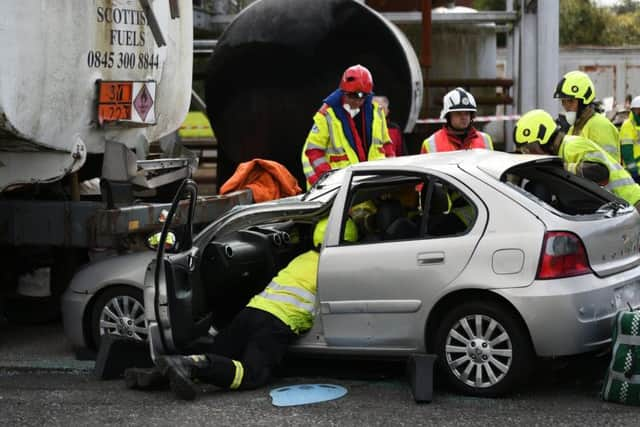

But I worried I was jumping the queue as I was moved over the heads of the other injured, still groaning from their injuries, although I knew I was playing the most critically hurt.
Lifted out of the train, I was lowered on to nearby grass. At this stage, my character in the rescue was transferred to a real dummy to be resuscitated, and that’s where it ended. Next year, organisers hope to extend the exercise to take casualties to hospital by ambulance, to involve trauma teams there too.
The operation I was part of takes place around four times a year at the SFRS headquarters in Cambuslang, on the southeastern edge of Glasgow.
Unlike bigger-scale exercises involving both the emergency services and other bodies, such as in the Clyde Tunnel, this training is specifically about honing the “nuts and bolts” of rescue techniques rather than managing major incidents.
Advertisement
Hide AdAdvertisement
Hide AdSurprisingly, it is one of the few times firefighters train with their counterparts in the Scottish Ambulance Service and the “flying doctor” Emergency Medical Retrieval Service, which airlifts casualties from remote areas.
Levin, who is based at the Royal Hospital for Children in Glasgow, said: “It’s a great opportunity to bring together different agencies as we all train in our own professional silos.
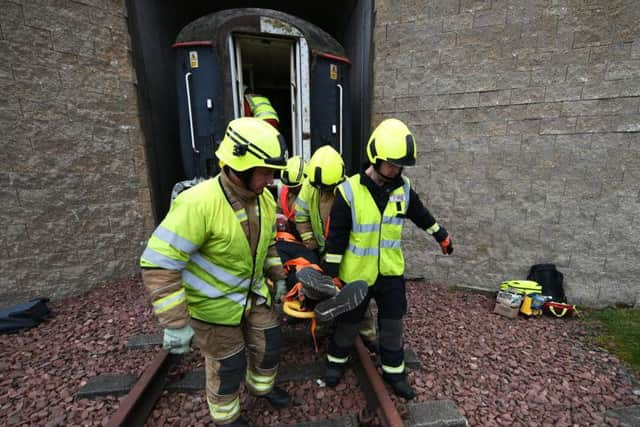

“We’ve also found the ambulance and fire services speak in separate languages – the terms we use mean different things.”
Firefighter Campbell, who joined the service in January, agreed: “It is really good interaction as we may go a month without coming into contact with ambulance staff.”
Campbell was among firefighters taking part from Easterhouse Fire Station in Glasgow, one of the SFRS’s five heavy rescue units, which are also located in Edinburgh, Alloa, Dumfries and Inverness.
The units are essentially fire engines with extra equipment, such as for lifting and cutting. Rail incidents they have covered include the Virgin Trains crash in Cumbria in 2007, the last time a passenger was killed on a train in Britain.
A unit was also deployed to the Glasgow bin lorry crash five years ago, in which six people were killed.
In a second exercise on Friday, the college students donned hard hats, safety goggles and masks to pose as road crash victims, with firefighters this time using cutting equipment and winches to prise apart a car and the cab of a lorry to free them.
Advertisement
Hide AdAdvertisement
Hide AdAlong the perimeter, a line of vehicles which had starred in previous such exercises awaited transfer to the scrapyard.
Beside them, stacked three high, like a static car transporter, the next ones sat ready to play their part in this vital work.